In the diverse world of avian wonders, few features capture human imagination quite like the striking eyelashes of the Secretary Bird. This remarkable creature, native to the African savannas, possesses eyelashes that would make any mascara brand envious. While birds typically don’t have true eyelashes as mammals do, the Secretary Bird’s distinctive eye features have earned it a reputation for avian glamour that rivals human beauty standards. These specialized feathers serve critical purposes beyond mere aesthetics, helping these birds navigate their challenging habitat while giving them an unmistakable appearance that has fascinated ornithologists and casual bird enthusiasts alike.
The Secretary Bird: Africa’s Glamorous Predator
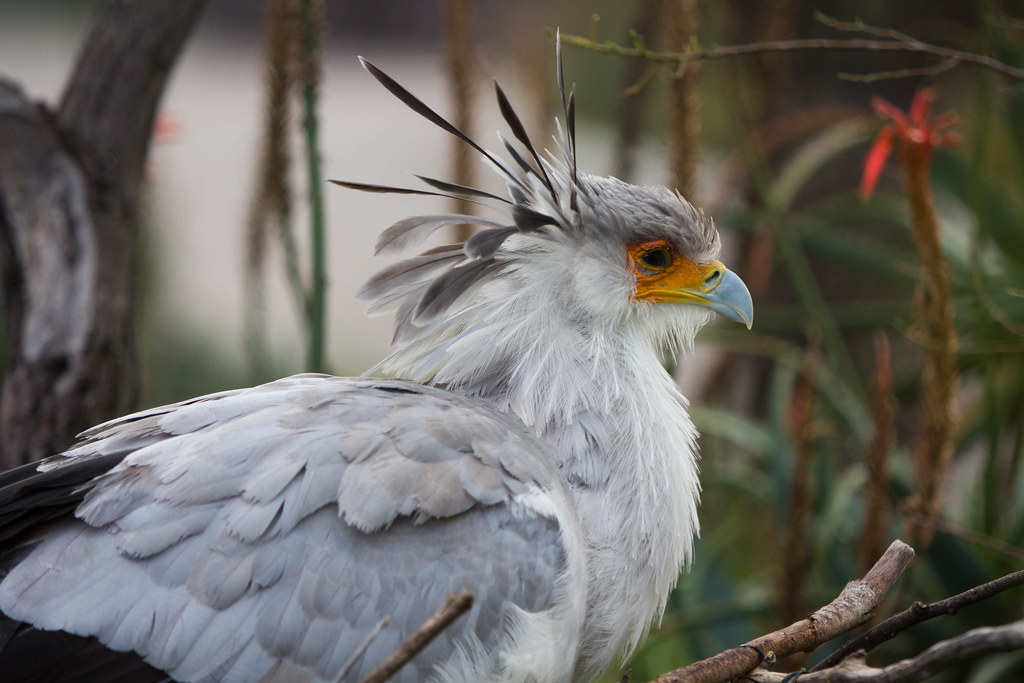
The Secretary Bird (Sagittarius serpentarius) stands as one of Africa’s most distinctive raptors, instantly recognizable by its long legs, eagle-like body, and elegant appearance. Standing nearly 4 feet tall with a wingspan reaching up to 7 feet, these birds command attention across the savanna landscapes they inhabit. Their name derives from the crest of long black feathers that project from the back of their head, resembling quill pens that secretaries once tucked behind their ears in the 19th century. These remarkable birds occupy a unique ecological niche as ground-dwelling raptors that primarily hunt on foot, using their powerful legs to stamp on prey while maintaining their dignified, almost regal bearing throughout the grasslands of sub-Saharan Africa.
Not True Eyelashes, But Specialized Feathers
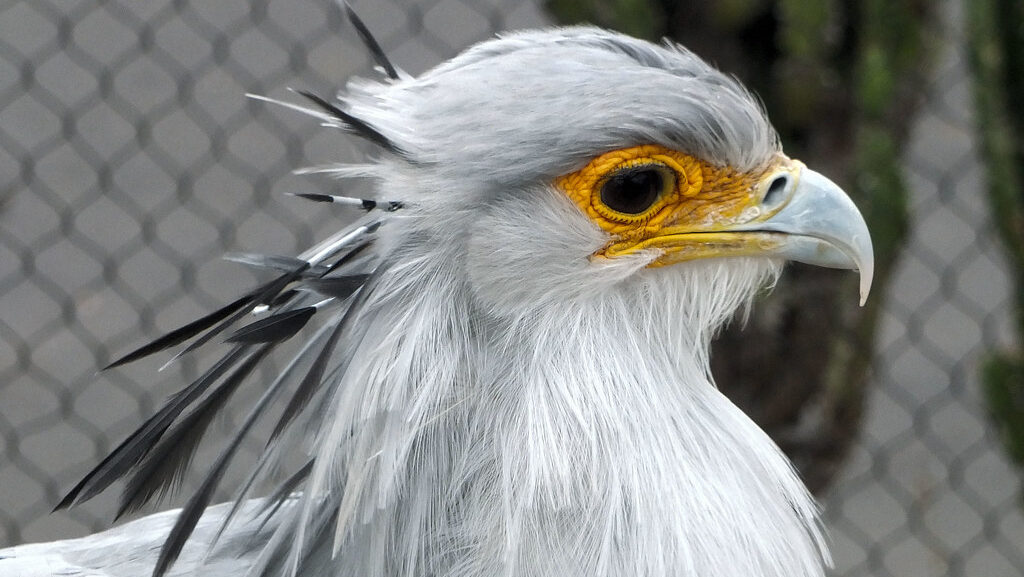
Despite their popular characterization, Secretary Birds don’t possess true eyelashes in the mammalian sense. What appears as extraordinarily long eyelashes are actually specialized feathers that grow around the eye area, creating the distinctive lash-like appearance. These modified feathers can extend outward from the eye in a fan-like arrangement that bears a striking resemblance to luxurious human eyelashes. Technically classified as bristles or modified contour feathers, they differ from mammalian eyelashes in both structure and development. Unlike human eyelashes which are specialized hairs with specific growth cycles, these avian “lashes” are part of the bird’s overall feather system and subject to the same molting patterns as other feathers on their body.
The Function Behind the Fashion
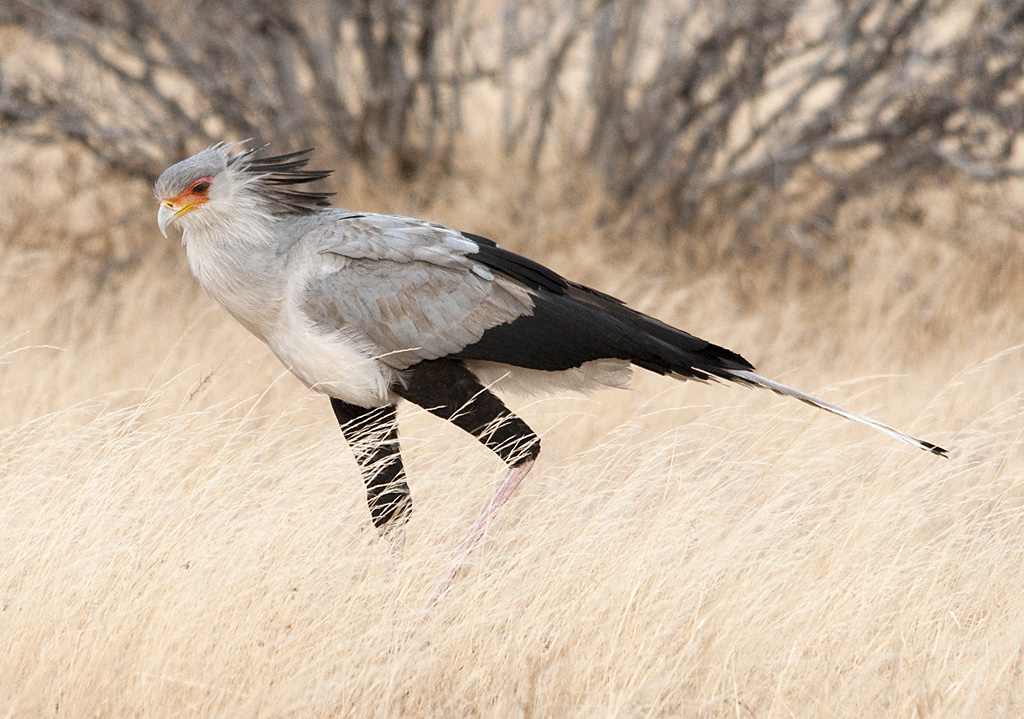
While these feathery eyelashes may appear decorative, they serve critical survival functions for the Secretary Bird. The primary purpose of these elongated eye feathers is protection from sun glare in the bright, open African savannas where these birds spend most of their time hunting. Additionally, these specialized feathers shield the bird’s eyes from dust and debris kicked up during their characteristic hunting technique, which involves stomping vigorously on the ground to flush out prey. The lash-like feathers also provide protection during encounters with dangerous prey like venomous snakes, creating a physical barrier that helps prevent potential eye injuries. This perfect blend of form and function demonstrates nature’s remarkable ability to develop specialized adaptations that serve practical purposes while creating visually striking features.
Hunting with Style: The Secretary Bird’s Predatory Behavior
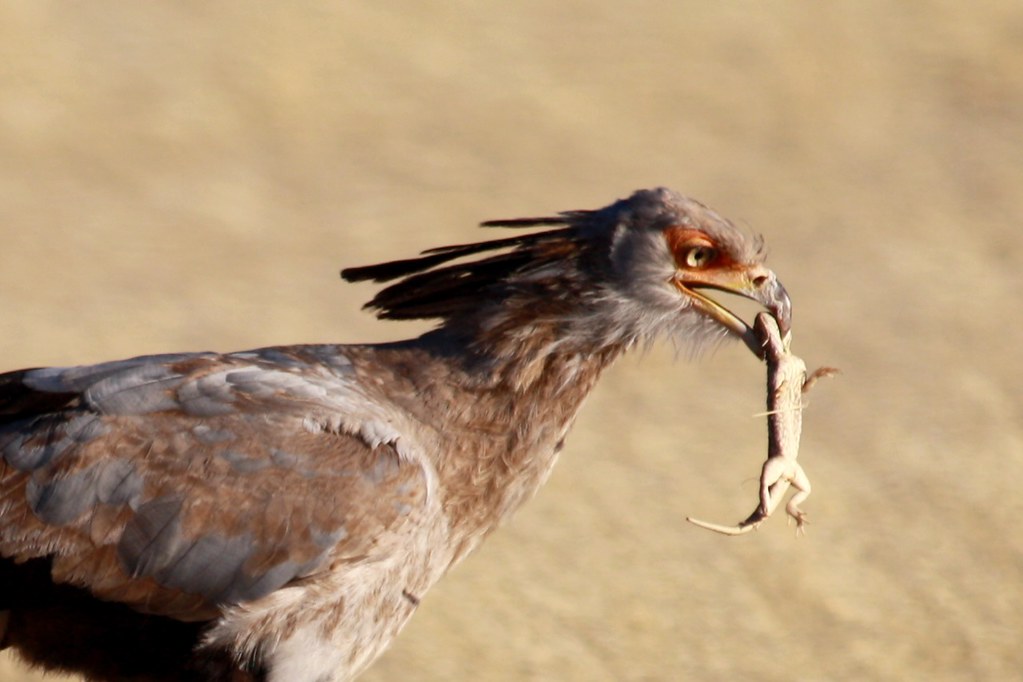
The Secretary Bird’s hunting style is as distinctive as its appearance, combining their extraordinary eye protection with powerful legs to create an efficient predatory approach. Unlike most raptors that rely primarily on flight and talons for hunting, Secretary Birds are terrestrial hunters that spend hours each day walking methodically through grasslands in search of prey. When they encounter potential meals—ranging from insects and rodents to snakes and even small mammals—they deploy rapid, powerful stomps that can deliver up to 5 times their body weight in force. Their specialized eyelash-like feathers become particularly important during these hunting sequences, protecting their vision while maintaining the visual acuity needed to track fast-moving prey. The combination of these features makes them particularly effective against venomous snakes, which they can dispatch without suffering bites due to their speed, precision, and protective features.
Evolutionary Adaptations for Savanna Life
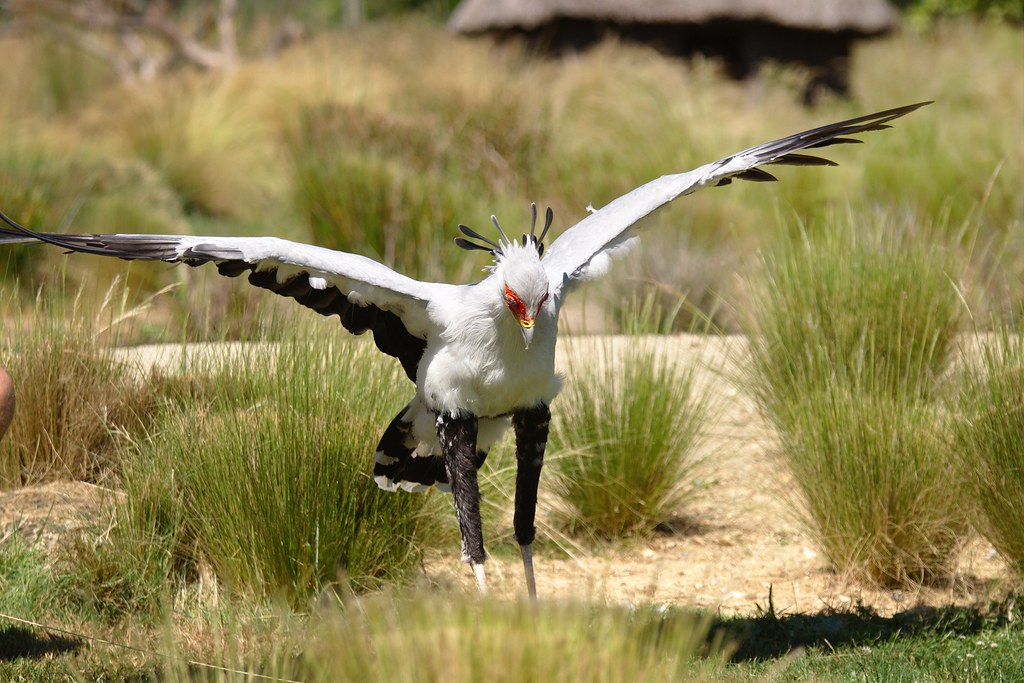
The Secretary Bird’s distinctive eyelashes represent just one aspect of their remarkable evolutionary adaptation to life in the African savanna. Their unusually long legs—the longest of any bird of prey—allow them to stride through tall grasses while keeping their body elevated above potential dangers. The crest feathers that resemble secretarial quills may serve communication purposes during courtship or territorial displays. Even their scientific name, Sagittarius serpentarius, references their snake-hunting prowess, with “serpentarius” directly acknowledging their preference for serpentine prey. The evolution of these specialized features, including their eye protection, represents millions of years of natural selection favoring traits that enhance survival in their specific ecological niche. This perfect adaptation to their environment makes them highly specialized predators unlike any other bird on the African continent.
Courtship and Mating: When Eyelashes Matter
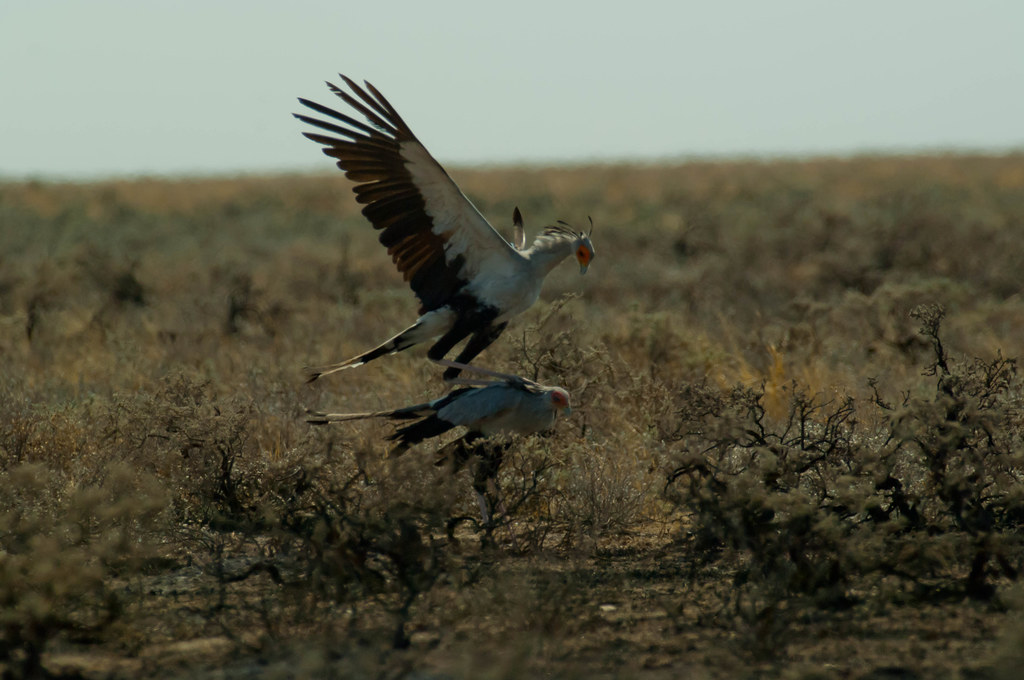
The Secretary Bird’s striking appearance, including their eye feathers, plays a significant role in their elaborate courtship rituals. During breeding season, pairs engage in spectacular aerial displays, with males performing soaring flights, spirals, and dramatic dives to impress potential mates. Once paired, both birds participate in an intricate bonding ceremony that includes mutual preening, where the birds may pay special attention to each other’s distinctive head and facial feathers. These courtship behaviors strengthen pair bonds that typically last for life, with established pairs returning to the same nesting sites year after year. The visual impact of their striking features, including their eye feathers, likely plays a role in mate selection, as is common among birds with distinctive physical characteristics that signal genetic fitness.
Nesting and Parental Care
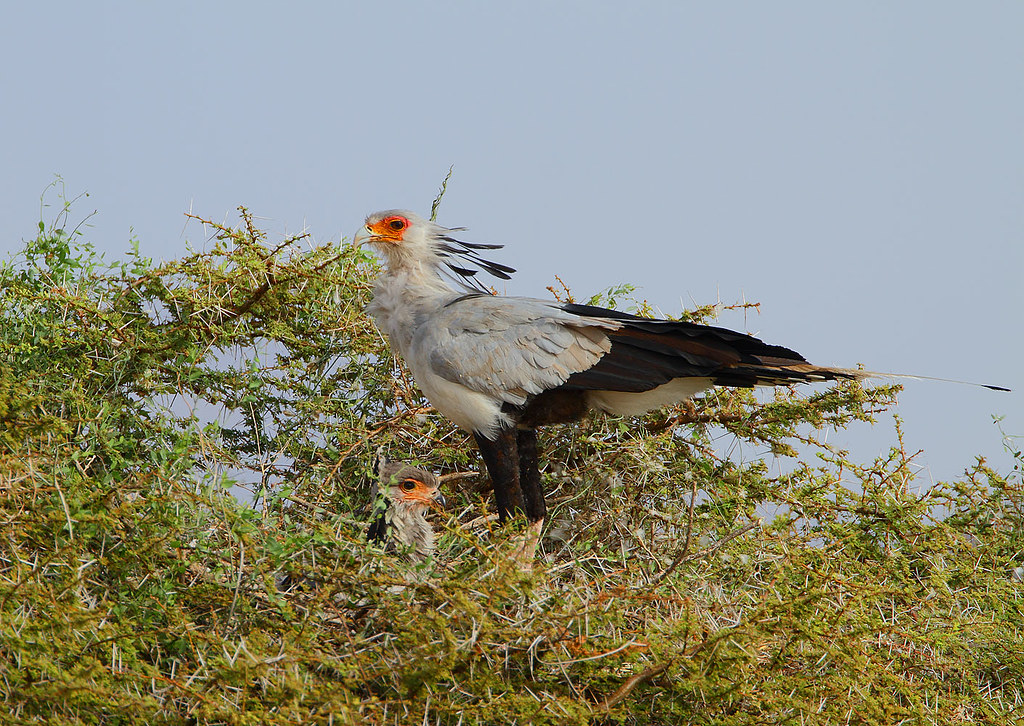
Secretary Birds create massive platform nests in the flat tops of thorny acacia trees, constructing homes that can measure up to 8 feet across and 1 foot deep. Both parents participate in nest building, incubating eggs, and caring for the young, demonstrating strong parental investment typical of monogamous raptors. When caring for nestlings, the parents’ distinctive eye feathers may provide an additional benefit by shielding their eyes from the intense sun as they scan the surroundings for potential threats to their vulnerable offspring. Chicks remain in the nest for approximately three months before fledging, during which time they gradually develop their own distinctive features, including the beginnings of their eye feathers. The extended period of parental care ensures young birds have time to develop the specialized hunting techniques and physical attributes they’ll need to survive independently.
Conservation Status and Threats
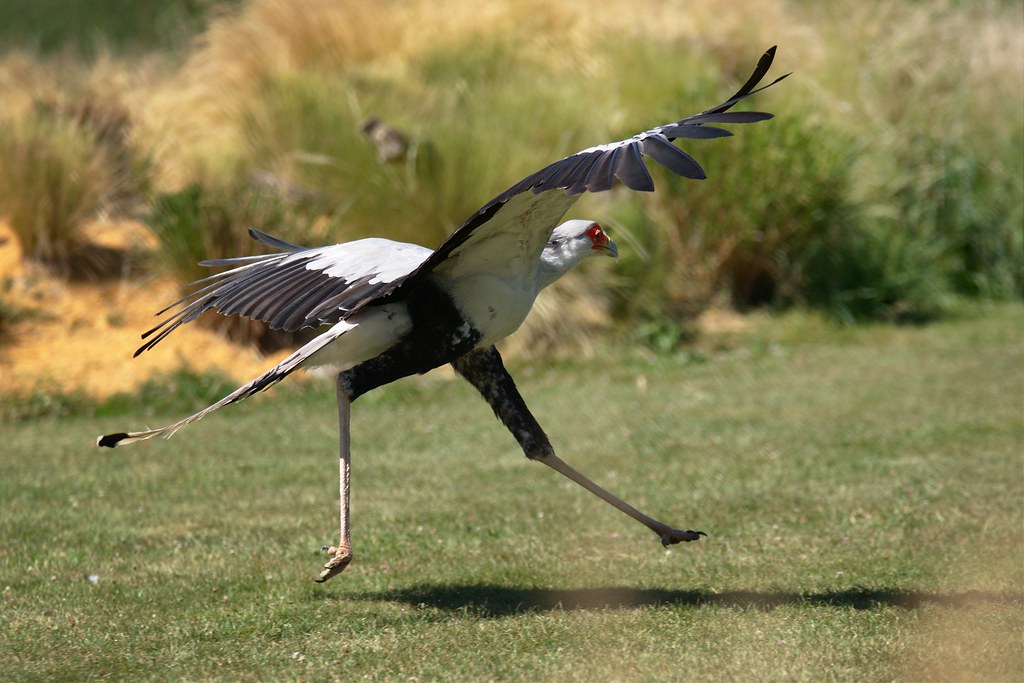
Despite their striking appearance and specialized adaptations, Secretary Birds face significant conservation challenges in the modern world. Currently listed as Vulnerable on the IUCN Red List, their populations have declined substantially across their range due to habitat loss, agricultural expansion, and human development. The conversion of grasslands to farmland has particularly impacted these birds, as they require expansive territories for hunting and breeding. Additional threats include collisions with power lines, road mortality, and deliberate persecution in some areas where they’re mistakenly believed to prey on livestock. Their specialized nature, including their ground-hunting technique and specific habitat requirements, makes them particularly susceptible to environmental changes that disrupt the open savanna ecosystems they depend upon.
Cultural Significance and Human Fascination
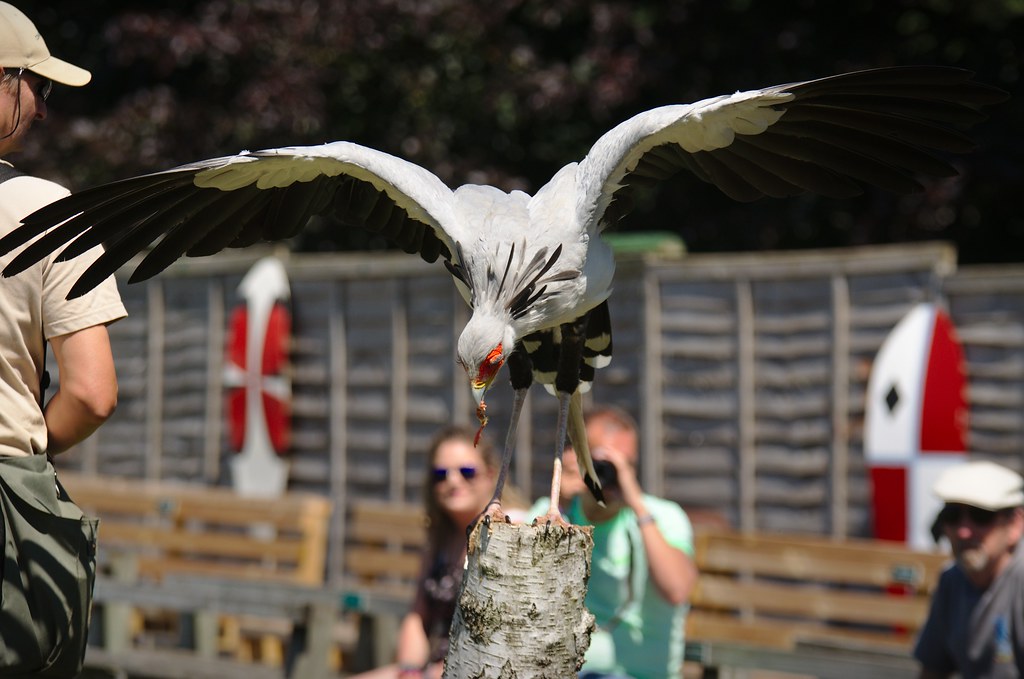
The Secretary Bird’s distinctive appearance has earned it significant cultural recognition across various African nations. In Sudan, the bird appears on the presidential seal and the coat of arms, symbolizing strength and protection. Similarly, the Secretary Bird features on South Africa’s national coat of arms, representing vigilance and readiness to defend the nation. Their snake-hunting prowess has made them symbols of triumph over evil in various cultural contexts, while their elegant appearance has inspired countless artistic representations. The striking eye feathers that resemble eyelashes have particularly captured human imagination, making these birds popular subjects in wildlife photography, nature documentaries, and even fashion inspiration. Their charismatic appearance ensures they remain ambassador species that help draw attention to conservation efforts for African grassland ecosystems.
Other Birds with Distinctive Eye Features
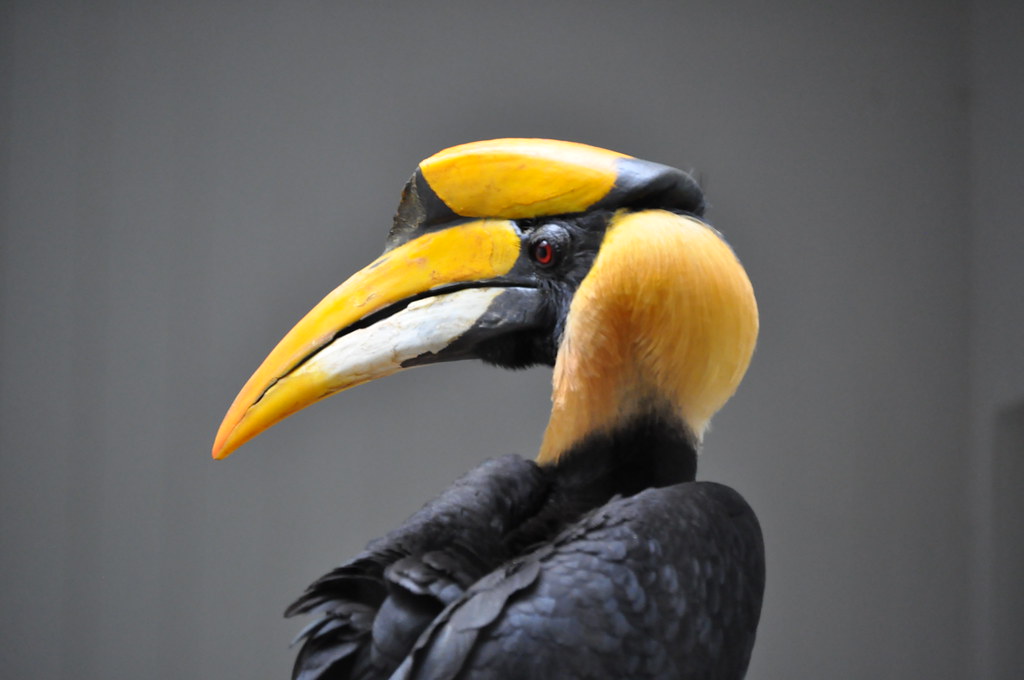
While the Secretary Bird may claim the title for most impressive “eyelashes,” several other avian species have evolved remarkable eye ornamentation. The Great Hornbill features striking eyelash-like feathers that contrast sharply with their brilliant eye color, creating a dramatic facial appearance. Numerous species of guineafowl possess distinctive bare skin around their eyes, often brightly colored, with small feather projections that create texture and dimension. The Southern Ground Hornbill displays prominent eyelashes that enhance their already intimidating appearance, complementing their massive bills and bright facial skin. Among hummingbirds, several species have developed specialized feathers around their eyes that create distinctive patterns or appear to frame their eyes like decorative masks. These varied adaptations demonstrate how eye ornamentation has evolved independently across multiple bird families, serving both practical and display functions.
Scientific Research and Recent Discoveries
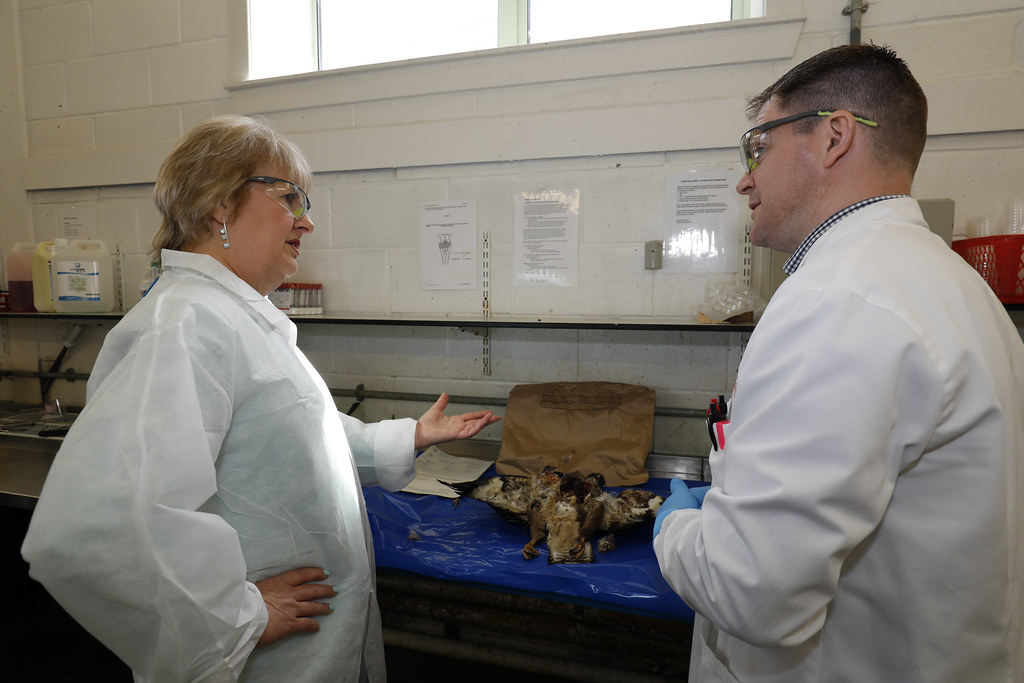
Recent scientific studies have shed new light on the Secretary Bird’s specialized features, including their eye protection. Biomechanical research has revealed that their hunting kicks can deliver forces five times their body weight at speeds of up to 15 feet per second, making them among the most powerful strikers in the animal kingdom. Ornithologists have also conducted detailed studies of their specialized feathers, including their eye feathers, using electron microscopy to better understand the microstructure that provides both protection and sensory capabilities. Tracking studies using GPS technology have revealed that individual birds require territories of up to 50 square miles, far larger than previously believed, with important implications for conservation efforts. Ongoing research into their visual systems suggests their eye protection may also play a role in enhancing hunting efficiency by reducing glare and improving contrast detection in varying light conditions.
Observing Secretary Birds in the Wild
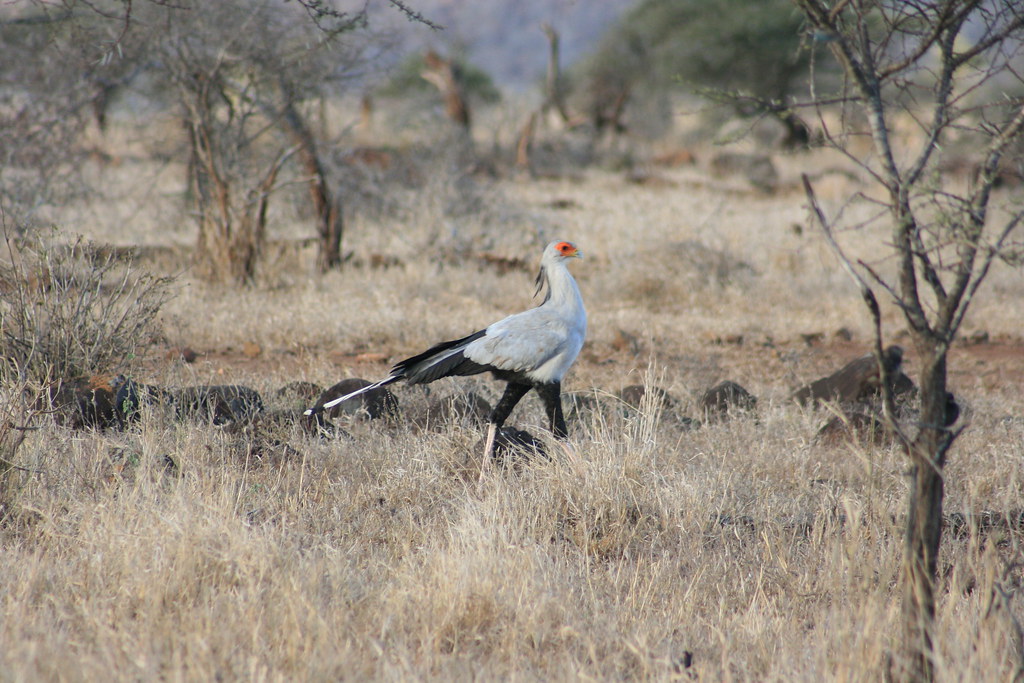
For wildlife enthusiasts hoping to observe these magnificent birds and their distinctive features, several protected areas across Africa offer excellent viewing opportunities. Kenya’s Masai Mara and Amboseli National Parks provide reliable sightings, particularly during the dry season when hunting birds are more visible against the sparse vegetation. South Africa’s Kruger National Park maintains healthy populations, with specialized bird-watching guides who can help locate these sometimes elusive raptors. The open plains of Tanzania’s Serengeti offer perhaps the best opportunity to witness their hunting behavior in action, as the vast grasslands perfectly match their preferred habitat. Botswana’s Okavango Delta provides a different perspective, where seasonal flooding creates a mosaic of habitats that concentrates prey and predators alike. When observing these birds, binoculars or spotting scopes are essential to appreciate the fine details of their remarkable eye feathers from a respectful distance.
Photography Tips for Capturing Avian Eyelashes
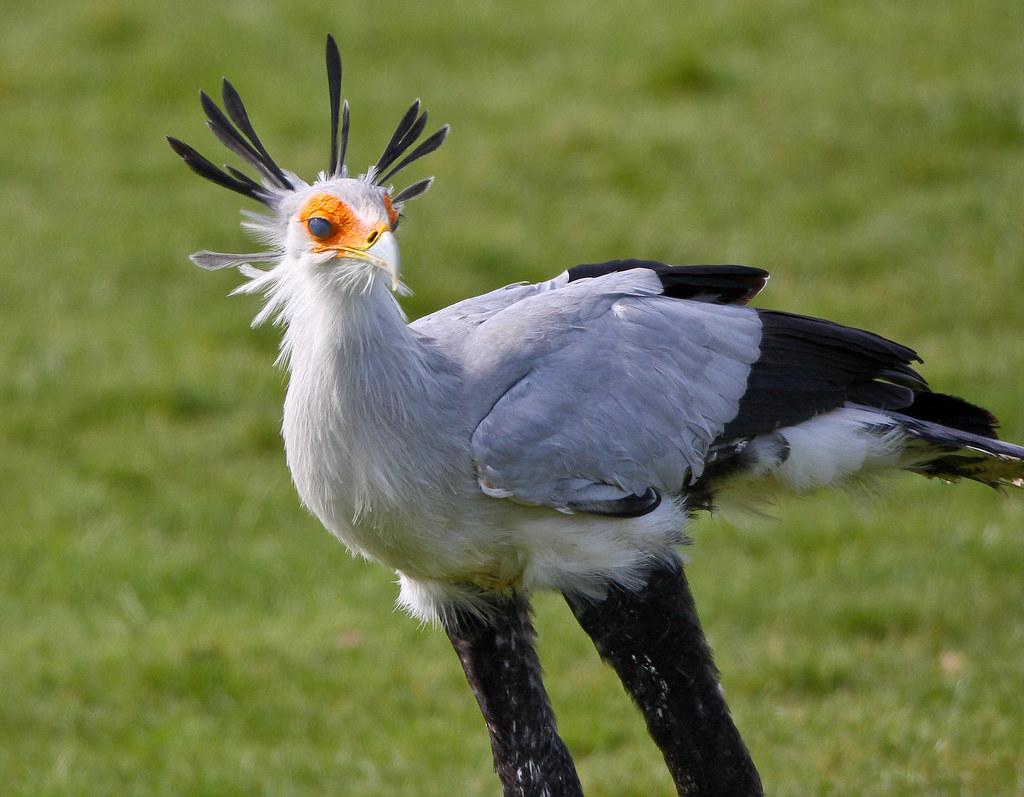
Photographing the Secretary Bird’s distinctive eye feathers presents both challenges and rewards for wildlife photographers. A telephoto lens of at least 400mm is essential, as these birds are typically wary of close human approach and maintaining appropriate distance prevents disrupting their natural behavior. Morning and late afternoon light proves optimal, as the low-angle sunlight illuminates their facial features and creates depth that highlights the texture and arrangement of their eye feathers. Patience is crucial, as capturing the perfect angle often requires waiting for the bird to turn its head to showcase its profile or face the camera directly. Professional wildlife photographers recommend using burst mode to capture sequences during hunting behavior, when the bird’s head movements may momentarily present perfect lighting and positioning of their distinctive features. Post-processing techniques that enhance contrast and detail without oversaturating colors can help accurately represent these remarkable feathers.
Conclusion
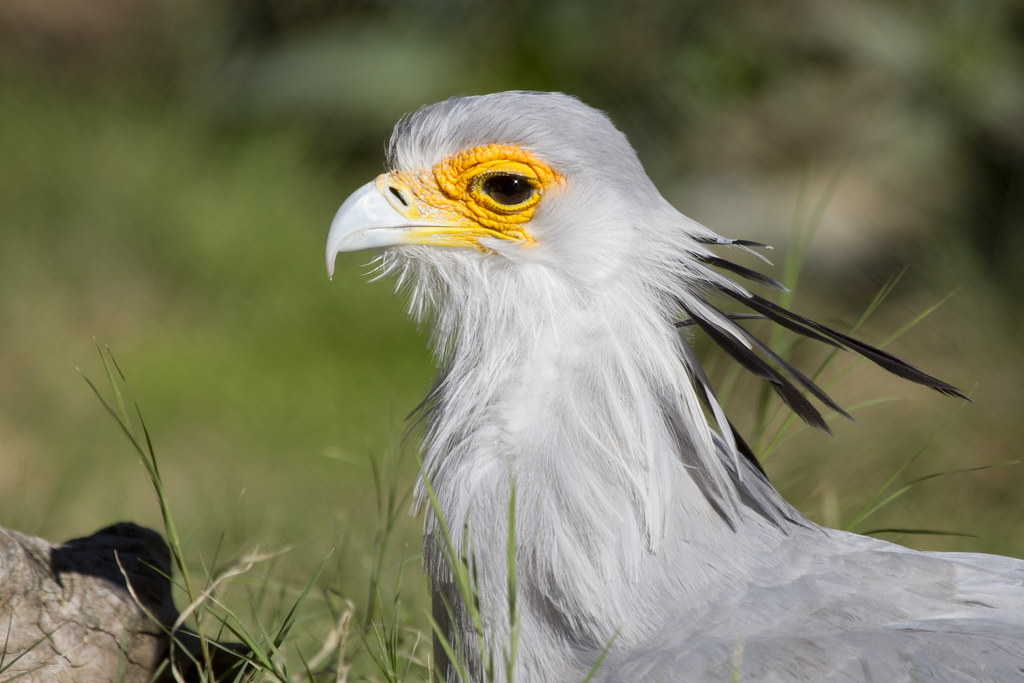
The Secretary Bird stands as a testament to nature’s creative adaptations, where practical function meets extraordinary aesthetic. Their specialized eye feathers—those remarkable “eyelashes”—represent just one aspect of a thoroughly specialized predator perfectly adapted to its ecological niche. While these features may inspire human admiration and even envy, they remind us that in nature, beauty often emerges from practical necessity. As these magnificent birds face growing conservation challenges, their eye-catching appearance helps draw attention to broader ecosystem protection efforts. The Secretary Bird’s glamorous appearance ensures it will remain an ambassador species, capturing human imagination while showcasing the remarkable diversity of avian adaptations that have evolved across millions of years of natural selection.
